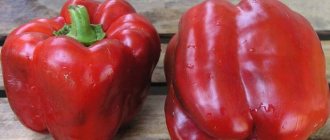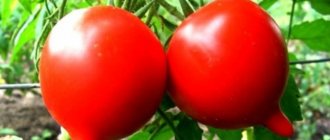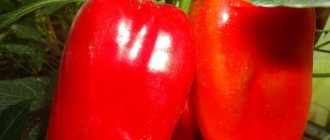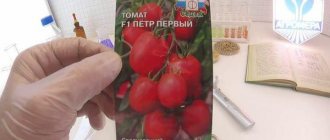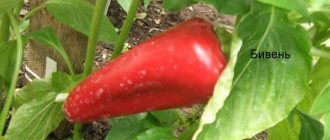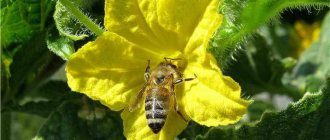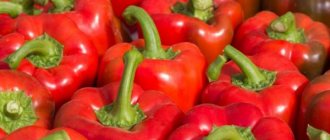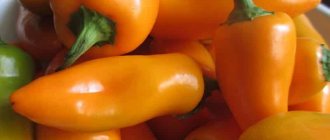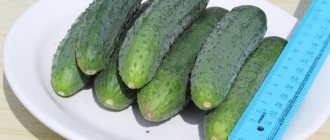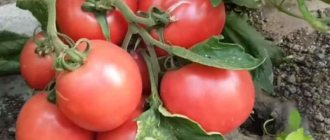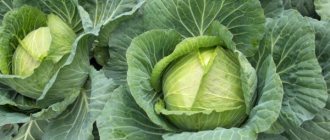What kind of pepper is this
Pinocchio is a high-yielding early hybrid, perfectly adapted to temperate latitudes . Large-fruited peppers are valued for their taste and look colorful in winter preparations. Caring for the crop will not be difficult.
Characteristics and description
The hybrid is resistant to the most common nightshade diseases. Tolerates heat, rainy weather, and lack of light. It is grown in greenhouses and open ground. The best harvest is produced in temperate latitudes.
Semi-determinate plant (reaches 1 m in height). The bushes have weak branches (2-3 shoots), but look spreading. The leaves are small, dark green.
Reference ! Semi-determinate crops stop growing at a certain point and are limited in growth. Their main advantage is early maturity.
Hybrid F1
If in the southern latitudes there are no problems with cultivation, then in the middle zone F1 hybrids must have specific qualities:
- ability to grow in open ground;
- ease of care;
- fast ripening times;
- unpretentiousness to weather conditions.
Pinocchio meets these requirements.
Distinctive features
Hybrid pepper Pinocchio has a number of features:
- good germination;
- resistance to tobacco mosaic, blossom end rot;
- long-term fruiting and storage;
- drought resistance;
- ability to grow in shaded areas.
Fruit characteristics, yield
Ripe fruits are red, large (about 17 cm in length and 8 cm in width), cone-shaped, with slight ribbing. The weight of each is 100–120 g, the wall thickness is 4–5 mm, the skin is dense.
Peppers are juicy, sweetish, and can be stored for a long time. The sugar content in them is 3.9%. Productivity is high: up to 13 kg per 1 m2.
Characteristics and description of the Buratino variety
Hybrid Buratino is an early ripening pepper. The yield of the harvest at the stage of technical ripeness occurs after 88-100 days. The countdown of the time of fruit appearance should begin after the seedlings have fully germinated.
The height of the plant varies between 0.7-1 m. The bush is spreading and does not require formation.
Characteristics and description of Buratino pepper F1:
- shape – elongated cone;
- fruit length – 15-17 cm;
- diameter – 6 cm;
- wall thickness – 0.5-0.7 cm;
- weight – 80-120 g;
- the pulp is juicy and aromatic;
- peel color – at technical ripeness it is dark green, at the stage of full ripening it changes to bright red (see photo).
The hybrid is a high-yielding one: with proper agricultural technology, from 1 sq. m. get 10.5-13.5 kg of vegetables.
Pepper has a salad purpose and is also used in canning. Fruits contain increased amounts of ascorbic acid (vitamin C)
The plant is planted in the ground using the seedling method. The hybrid is suitable for growing in heated and unheated greenhouses, greenhouses and beds not protected by shelter.
Preparation for cultivation
Sowing of seedlings begins in February - March. Use light soil with good drainage or a ready-made soil mixture. At home, mix peat, sand and soil in equal parts and add humus.
The largest seeds are chosen, without cracks. When placed in a saline solution they will sink to the bottom.
Methods for processing planting material:
- place in warm water (no more than +50 °C) for 4 hours, wrap in a damp cloth and keep for several days;
- hold in the potassium permanganate solution for 20 minutes;
- place in a 40% hydrogen peroxide solution for 10 minutes, do not rinse, dry;
- treat with growth stimulants: Epin, Zircon and others;
- hold in ash solution to boost the immunity of future sprouts;
- place in the refrigerator for 1 week, then for 1 day in a mixture of water and aloe juice.
Important! When soaking seeds, do not allow them to be completely immersed in liquid.
Seed germination is up to 70%.
Features of growing pepper
In the southern regions, the Buratino F1 pepper variety can be grown in open ground, and in all others - in shelters and greenhouses. In both cases, the seedling method is used.
Preparing seeds for sowing
Seeds purchased by weight should be soaked in a saline solution for 10 minutes (1 tablespoon of salt per 1 liter of water). Empty seeds will float, and full seeds will sink to the bottom. It will be necessary to drain the water containing the floating seed material, and rinse the remaining material.
To increase resistance, dry seeds can be hardened. To do this, during the daytime we keep them in a warm room (+20…+22ºС), and at night we place them on the refrigerator shelf at a temperature of +2ºС. This regime lasts 3 days.
Before planting, seeds must be disinfected. The easiest way is to immerse them for 20 minutes in a light solution of potassium permanganate (10 g of powder per 1/2 liter of water). They should then be washed.
For better germination, seed material can be soaked in stimulants (Epin, Zircon) for 12 hours. Then dry it by laying it on a natural piece of fabric. Instead of stimulants, you can use an ash solution, which will perfectly saturate the pepper seeds with the elements it needs. For this, 2 tbsp. l. ash is infused for 24 hours in 1 liter of water. Then the solution is filtered and seeds wrapped in gauze are dipped into it for 5 hours. They are then dried on a cloth. After soaking seeds in stimulants and nutrient solutions, they are not washed.
We advise you to read whether it is necessary to chop bell peppers.
It is recommended to germinate pepper seeds before planting in the ground. To do this, they are wrapped in damp gauze and kept in a room with a temperature of +20…+25ºС. You need to keep the gauze moist, and in 2-3 days the seeds will hatch.
Selecting containers for seedlings
Pepper seedlings grow best in a separate container. Seeds can be sown immediately in a container where they will grow until planting, or they can be planted in a common container and then planted. It is quite acceptable to grow peppers in a common box, 10 cm deep. The distance between plants in a common container should be at least 6 cm.
As separate containers, you can use boxes, plastic cups, peat pots, cut plastic bottles and packs of dairy products. Drainage holes are made in them. You can buy pots for seedlings or cassettes.
Important! Individual containers for pepper should not be less than half a liter.
The seedlings that will be picked can be first sown in shallower dishes 5 cm deep, and then, after the second leaf appears, picked into individual dishes. It must have drainage holes.
Preparing the land for seedlings
The most convenient way is to buy ready-made universal soil at an agricultural store.
If you wish, you can create the following mixtures yourself:
- 2 parts of soil from the beds, 2 parts of humus, 2 parts of peat and 1 part of sand;
- 2 parts of turf, 2 parts of peat (high), 1 part of humus or compost and ½–1 part of sand.
The homemade mixture must be disinfected by pouring a weak solution of potassium permanganate or calcined in the oven. This must be done 2 weeks before disembarkation. Before planting seedlings, a bucket of soil mixture can be mixed with a glass of ash or 30 g of nitroammophoska.
Sowing seeds for seedlings
The seeds are embedded in the soil mixture to a depth of 1–1.5 cm. 1–2 seeds are planted in individual containers, and then only one plant is left - the strongest one. Seeds are planted in a common container for subsequent picking at a distance of about 2 cm from each other. The soil is moistened and the containers are covered with a film on top, which is removed daily for 20 minutes to ventilate and control the moisture content of the substrate.
The temperature before emergence should be maintained at +25...+28°C. When the shoots appear, remove the film and transfer the containers with the sprouts to a lighted place. If there is sufficient heat, seedlings appear on days 5–7, and if there is not enough heat, then a little later.
Did you know? The culture of capsicum was brought to us from the American continent after its discovery by Columbus. In tropical areas, its wild species still grow there.
Features of caring for seedlings
For the first few days from the emergence of seedlings, temperatures are maintained within +15...+18°C so that the sprouts do not stretch. After 5 days, you can increase the temperature to +20...+25°C. Watering is carried out with warm, settled water at the root. It is best to do this in the morning. The soil should not dry out, but there is no need to flood the plants.
On bright sunny days, young seedlings are slightly shaded from the hot rays of the sun. To prevent it from stretching in one direction, containers with it are recommended to be turned with different sides towards the sun. About a month later, when the second leaf appears, the peppers, planted in a common seedling container, are dived into a separate container.
For pepper seedlings, fertilize at least twice:
- in the phase of 2–3 leaves or 2 weeks after picking;
- a week before disembarkation.
For fertilizing, it is most convenient to use ready-made complex fertilizers for seedlings (Agricola, Lux, Mortar). If the soil was unsuitable and the seedlings do not grow well, then you can feed them with urea (4 g/1 l of water).
Two weeks before planting, the seedlings are hardened by taking them out onto the balcony during the daytime. At first, the seedlings are there for only a few hours, then this time is increased, and before planting the plants spend the night there. Plants are gradually accustomed to the sun and first protected from direct rays.
Transplanting seedlings into the ground
Early varieties are transplanted into soil at the age of 50–60 days. At this time, the plant should begin to produce buds. The threat of frost should pass and the soil in the beds (open or protected) should warm up to +14...+16°C.
You will be interested to know about the best varieties of indoor peppers.
For planting, choose a sunny place where peppers and other nightshade crops have not previously grown. The beds are prepared in advance in the fall. Organic matter is added to the soil during autumn digging. Sawdust, peat, and manure are embedded in the loams. In clay soils, in addition to this mixture, sand is added. In the spring, they are fertilized with mineral complexes, mainly with potassium and phosphorus.
For 1 m² add:
- 1 glass of ash;
- 1 tbsp. l. superphosphate;
- 1 table. l. potassium sulfate;
- 1 tsp. urea.
The seedlings are well watered and planted with a distance between bushes of 35–40 cm and row spacing of half a meter. In greenhouses there are no more than 7 bushes per 1 m².
If there is a threat of frost or a drop in temperature, plantings are covered with lutrasil or other covering material.
Growing seedlings
Seedlings are first germinated in a common container and then planted, or they are immediately planted in separate containers.
With a pick
The seeds are planted in boxes and covered. Ground temperature - +15 °C. The emerging seedlings are provided with good lighting and regular ventilation. Constantly monitor soil moisture. The film is removed after 14 days and mineral fertilizers are applied.
Important! The seedlings are additionally illuminated with phytolamps, since there is not enough natural sunlight for the plants at this time of year.
After the appearance of 2 pairs of true leaves, picking is carried out. Seedlings are moved into cups, preferably peat cups. The room temperature is maintained within +25…+27 °C, but not lower than +20 °C. On the eve of planting in the ground, the crop is gradually taken outside, strengthening its adaptation to new conditions.
Without picking
This growing method is less traumatic for the delicate roots of peppers. Place 2 seeds in separate cups at once. One of the sprouts (the weaker one) is subsequently removed. After 4 true leaves appear, the plants are transferred to larger pots.
Features of agricultural technology of a hybrid variety
Grow Pinocchio pepper with seedlings. Sowing is carried out according to the proposed scheme. The optimal temperature for seed germination is about +25 ºС. The plant is ready for picking at the 1-leaf stage, and for transplanting to a permanent place - at the age of 70 days. Place on 1 sq. m from 5 to 8 bushes. The stems do not need garter.
Advice. When sowing in the first half of March, take care to provide additional lighting to the container. To plant in heated greenhouses in the spring-summer rotation, start work half a month earlier.
Sowing seeds for seedlings | Planting seedlings in a greenhouse/greenhouse | Planting seedlings in exhaust gas | Stepsoning | Harvesting (in the greenhouse / in the greenhouse) |
| All March | Late May-early June | The beginning of June | Not necessary | July August |
| *dates are indicated for central Russia | ||||
Planting pepper
Planting to a permanent place begins in the last days of April, in warm weather, in the afternoon. The distance between the holes is 35-40 cm, between the rows - 50 cm. A handful of humus and ash are placed in the holes. Planting density - 7 bushes per 1 m2.
Pinocchio has a weak root system: the hybrid is planted in places protected from gusts of wind, as the plants can break.
Attention! This is a self-pollinating hybrid: it is not planted next to other varieties of peppers to avoid the transfer of pollen from them.
Similar pepper hybrids
In terms of characteristics and descriptions, Pinocchio pepper can be compared with the following hybrids:
- Fisht;
- Samander;
- Gypsy;
Fisht F1 is an early ripening hybrid. Fruit ripening occurs 50-60 days after planting the plants in a permanent place. The peppers are cone-shaped, very thick-walled - up to 1 cm, but in some cases, according to the originator, the thickness can reach 2 cm. The plant is resistant to verticillium, tolerates heat and moisture deficiency well.
Samander F1 is an early-ripening, low-growing hybrid. It is distinguished by its high yield: up to 20 fruits are formed on 1 bush. Peppers are cone-shaped, dense, with a wall thickness of 6 mm, a length of 15-18 cm and a diameter of up to 6 cm, 2 or 3 chambered. The weight of one fruit is 110-120 g. Tolerates adverse weather conditions well.
Gipsy F1 is a hybrid with a ripening period of 85-90 days from the beginning of the growing season. Productivity is low: up to 4.2 kg. from the bush. The plant has stable immunity to the complex of nightshade diseases. At the stage of full maturity, the fruits acquire a rich red color. They have a conical shape, the wall thickness does not exceed 8 mm. Pepper length is 13-15 cm, weight is on average 120 g.
Further care
After transplanting seedlings into open ground or a greenhouse, the following activities are periodically carried out:
- Loosening the soil: roots need to breathe.
- Watering is carried out daily at first, and when the plants get stronger, reduce it to 2 times a week. Use warm water.
- Fertilizer. A total of 3 feedings are applied: the first - after planting, the second - during the flowering period, the third - during fruiting. They use an infusion of droppings, manure, ash, and solutions of mineral fertilizers. When signs of plant wilting appear, foliar feeding is performed on the leaves.
- Topping. They do this as needed: the bushes do not branch much, so they do not need shaping. Remove the crown flower (formed in the center of the bush).
- Hilling. Carry out for the growth of the root system.
Selecting soil for planting and fertilizers
Before transplanting into open ground, plant each seed separately in its own cup of soil. The glass should hold at least 200 g, since excessive crowding can interfere with the effective development of the plant.
When choosing soil, give preference to one that is light in weight and loose. It can be purchased at a specialty store, but there is a way to make soil yourself, without extra costs.
To do this, perform a few simple manipulations:
- use peat, sand and soil in equal proportions;
- add humus to the soil to saturate it with the necessary enzymes;
- If necessary, dilute the soil with chemical industry materials.
Important! Never add the substrate to already rotted humus, since the nitrogen released in this case can destroy your plant in the early stages of germination.
Conditions for keeping and caring for Buratino pepper
Pepper Buratino is a heat lover. As soon as you find the first shoots, do not allow the temperature to drop to less than 130C. The most favorable temperature will be 25-27 degrees. The plant can be hardened only after the 8th leaf appears. During this period, the temperature is deliberately lowered during the week to 16 degrees.
Do not allow the soil to become too dry, although a slight lack of moisture is not a problem for this type of crop. Water your plant exclusively with warm, settled water.
Typical diseases and pests
The hybrid has average resistance to tobacco mosaic and blossom end rot. With proper agricultural technology, the crop is not affected by other diseases.
Pests that threaten peppers:
- Aphids - attack all leaves and flowers. Control measures: treatment with rapidly decomposing insecticides (“Keltan”, “Karbofos”) at the rate of: 1 tbsp. l. drug per 10 liters of water. For preventative purposes, the products are used before and after the bushes bloom. During the fruiting period, chemicals are not used.
- Spider mite - feeds on plant sap. The bushes die in a short time. Control measures: treatment of the bushes themselves and the soil underneath with acaricides. They use special sticks that are buried in the ground. During watering, they dissolve, the poison releases into the soil and enters the plant itself. Plant-Pin, Ethisso, Substral, and Green House-Dust are suitable for these purposes.
Spider mite on pepper.
Possible diseases :
- Verticillium . Signs: wilted or curled leaves with brown or yellow spots. The lesion can occur on only one branch. The fungus penetrates the roots and spreads throughout the plant. Control measures: treatment of bushes and soil with fungicides (Vitaros, Previkur, Fundazol, Topsin M, Maxim).
- Alternaria blight. The reason is a constant temperature difference. The main features: dark brown angular spots on the leaves, water stains on the fruits and a small fluff on the stems. The fungus attacks the inside of the peppers. The disease progresses in dry weather. Control measures: treatment of bushes with a solution of Bordeaux mixture at the rate of 100 g of the drug per bucket of water.
Reviews from ordinary gardeners
There are enough reviews about this hybrid on thematic forums. Many gardeners note poor germination of pepper seeds. But in general, people are satisfied with the characteristics and behavior of the crop in the garden. The variety appears in high positions in various horticultural ratings.
Alevtina grew a full-fledged early ripening crop on an open-air plot in the Moscow region. Tatyana from Moscow also praises this sweet pepper. She especially notes the taste. Olga from Tula uses the fruits for stuffing. She likes the result.
Bell pepper Buratino F1 is an excellent hybrid in its qualities. The plant needs to be looked after in the garden, but it is unpretentious to the weather. Gardeners note a significant disadvantage of the hybrid - not all seeds germinate. But the yield and quality of peppers will please the owners of their plots.
Advantages and disadvantages of a hybrid
Advantages of Pinocchio F1:
- high productivity;
- large fruits;
- ease of care;
- early ripening;
- disease resistance;
- high content of vitamin C (204.5 mg per 100 g);
- suitability for conservation;
- long shelf life (ripe fruits at a temperature of +2 °C and 90% humidity retain their taste and presentation for 60–90 days);
- bushes do not require shaping.
Flaws:
- sometimes a garter is required;
- impossibility of using your own seeds, since it is a hybrid.
Harvesting
The hybrid produces a harvest from July until the weather gets colder. To increase productivity, fruits can be harvested immediately after reaching technical ripeness, so that those remaining on the bushes can receive maximum nutrients. Peppers have a high content of vitamin C (204.5 mg/100 g). Suitable for fresh consumption and canning. The aroma and brightness of taste do not change after heat treatment.
Storage features depend on the stage of ripeness at which the crop is harvested:
- Green peppers can be stored for up to 90 days at a temperature of 7-10°C and air humidity of 90-95%, in warmer rooms with lower humidity levels - up to 26-30 days. For longer storage, each fruit can be wrapped in paper and placed in plastic or wooden boxes.
- Red fruits are well stored in the vegetable drawer of the refrigerator for up to 60-90 days, provided that there are no rotten specimens among them.
Related article:
What varieties of peppers are best to plant?
Reviews
Vegetable growers share their impressions, observations and experience in growing a hybrid:
Valentina, Voronezh : “I’ve been growing this pepper in a greenhouse for the second year now. To increase productivity, I advise you to pick peppers at the stage of technological maturity, that is, green ones. This way you free the bushes, and they have the strength to form new fruits.”
Mikhail, Moscow region: “Pinocchio grows better in a greenhouse. The harvest is stable and good. I noticed that if you remove the crown flower, fruiting slows down. That's why I'm leaving him."
Marina, Leningrad region: “I’ve been growing Pinocchio for several years in a row. The bushes are always large, the stems are as thick as a finger. The year before, heavy rain bent the bushes, some even broke. Since then I decided to tie it up, even if the bushes are not tall. The peppers are bright, as in the photo, very tasty both fresh and canned. The aroma is fragrant, I love adding vegetables to salads. I like them even in a state of technical maturity.”
Ivan, Lipetsk: “Due to my inexperience, I made a mistake, and my peppers were pollinated with a bitter variety. I advise you not to grow different peppers within the same area.”
Reviews of Buratino pepper
Most reviews from gardeners about Pinocchio pepper are positive. Those who have been growing this variety for a long time speak about the unpretentiousness of the plant, since its maintenance requires a minimum of effort. This variety is versatile and can be used in a wide range of culinary dishes.
Many gardeners consider the main advantage that Pinocchio pepper consumes less moisture compared to other types of crops. Thus, experienced people in this matter consider growing Pinocchio pepper to be economical and at the same time profitable - good yield and weight of fruits allow you to get a high yield at the end of ripening. At the same time, the speed of maturation is no less pleasing.
Sweet pepper "Agapovsky"
This variety of sweet pepper belongs to the medium ripening varieties. The period from planting to harvesting ripe fruits is about four months.
The bush of this pepper is small in size, but it has many leaves. The leaves are large in size and dark green in color.
Culture is semi-determinant. The height of the bush is on average 85-90 cm.
The pepper itself is quite large and has a prism-shaped shape. Small ribs also protrude and are smooth to the touch.
The fruits on the bush are in a drooping position. There is little or no depression of the fruit stem. Number of nests 3-4. The weight of one fruit is about 120 grams, the wall is up to 9 mm thick.
It has a fairly strong aroma and a pleasant taste. The pepper pulp is juicy. The color of the fruit during ripening is dark green.
During biological ripeness, the color is red. This variety of pepper contains the following components: dry matter 6.4%, sugar 3.6%, ascorbic acid 206.5 mg per 100 grams of raw material.
The yield of this pepper is 9.4-10.3 kg/sq.m. The yield of marketable products is 98%.
Positive aspects of Agapovsky pepper:
- This plant is a medium ripening variety.
- Pepper has high commercial qualities.
- A good indicator is its high yield.
- A positive factor is the good resistance of pepper to various diseases.
- The pleasant taste and aroma of the crop is also important.
- Used in such areas as canning, eating raw, stewing, etc.
The disadvantages of this plant include:
- Agapov pepper loves light, so it needs to be planted in well-lit places, otherwise the buds and ovaries may fall off.
- It is necessary to monitor watering of the crop, as it does not tolerate drought well.
